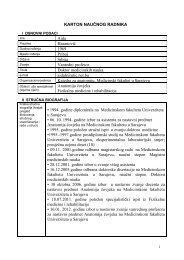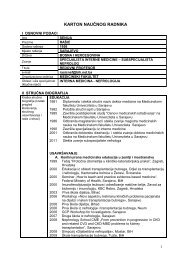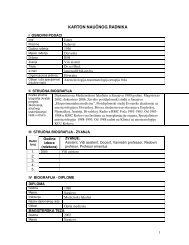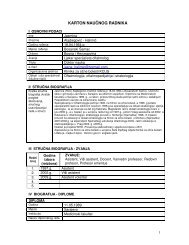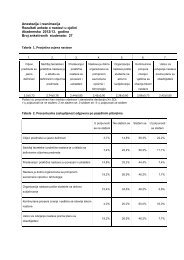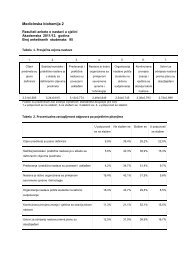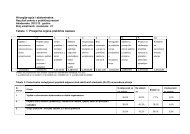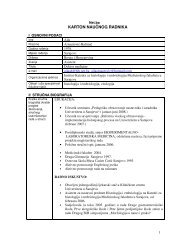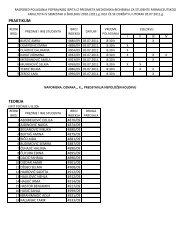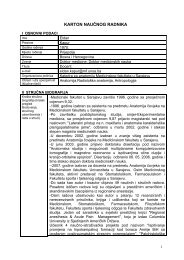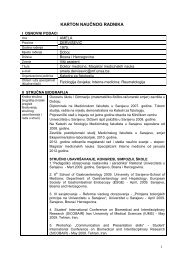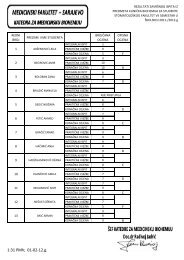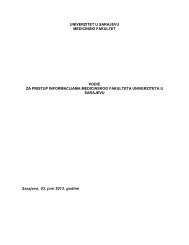Contents - Medicinski Fakultet u Sarajevu - University of Sarajevo
Contents - Medicinski Fakultet u Sarajevu - University of Sarajevo
Contents - Medicinski Fakultet u Sarajevu - University of Sarajevo
Create successful ePaper yourself
Turn your PDF publications into a flip-book with our unique Google optimized e-Paper software.
Folia Medica 2011; 46 No 1:48-53function, it may lead to suboptimal resultsin some circumstances (6).Several methods are used for evaluation<strong>of</strong> the function <strong>of</strong> β-cells and the degree <strong>of</strong>insulin resistance such as clamp technique,frequently sampled intravenous glucosetolerance test (FSIVGTT) and continuousinfusion <strong>of</strong> glucose with model assessment(CIGMA) (8).Clamp technique is considered as a referencetechnique for the determination <strong>of</strong>insulin sensitivity in humans, because itdirectly measures the metabolic effect <strong>of</strong>insulin in precisely set conditions. It can beimplemented in euglycaemic, isoglycaemicand hyperglycaemic conditions. However,it is also the most complex technique as itrequires the simultaneous administration<strong>of</strong> the glucose and insulin, multiple bloodsampling and experienced operator (a physicianor a technician) over a course <strong>of</strong> 3 and6 hours, respectively (8).In the quest for noninvasive measurementtechnique for insulin sensitivity, severalfasting or “homeostatic” models havebeen proposed such as fasting glucose/insulinratio (FGIR), quantitative insulin sensitivitycheck index (QUICKI) and homeostaticmodel assessment (HOMA). Thesemethods have been the most frequentlyused techniques in clinical investigations.The fact that these tests require only a singlevenipuncture in fasting state and do not callfor concomitant intravenous access makesthem particularly attractive to patients andclinicians alike (9).Types <strong>of</strong> HOMA modelHOMA 1: The original HOMA modelHomeostatic model assessment was firstdescribed in 1985 (Matthews et al.). It is astructural mathematical model which allowsvalues for insulin sensitivity (which isreciprocal <strong>of</strong> insulin resistance) and β-cellfunction, expressed as a percentage <strong>of</strong> normal,to be obtained if simultaneous fastingplasma glucose and fasting plasma insulinor C-peptide concentrations are known (6).These parameters can be used by means <strong>of</strong>the following formulas (10):HOMA-IR= (FPI x FPG)/22.5HOMA-%B= HOMA-IR – (20 x FPI)/(FPG-3.5)(HOMA-%S= 100/HOMA-IR)IR= insulin resistanceFPI= fasting plasma insulin level; FPG=fasting plasma glucose level% B= % <strong>of</strong> functional β-cells in the pancreas;% S= % <strong>of</strong> insulin sensitivityThe relationship between glucose and insulinin the basal state reflects the balancebetween hepatic output and insulin secretion,which is maintained by feedback loopbetween the liver and β-cell. The predictionused in the model arises from experimentaldata in humans and animals (11).The approximating equation, in earlymodel, used a fasting plasma sample, andwas derived by use <strong>of</strong> the insulin-glucoseproduct, divided by a constant (assumingnormal weight, normal subjects



